Improving the Performance of Micro-Textured Cutting Tools in Dry Milling of Ti-6Al-4V Alloys
Abstract
:1. Introduction
2. Experimental
2.1. Preparation of Micro-Textured Cutting Tools
2.2. Milling Tests
3. Results and Discussion
3.1. Single-Factor Tests
3.1.1. Resultant Cutting Force
3.1.2. Cutting Temperature
3.1.3. Surface Roughness
3.1.4. Tool Life
3.1.5. Power Consumption
3.2. Taguchi Tests
3.3. Discussion
4. Conclusions
- Compared to conventional tools, micro-textured tools can reduce the resultant cutting forces and the cutting temperatures by 15% and 10%, respectively. The tool lives of so-called micro-textured tools are improved by approximately 20–25%. Meanwhile, the developed tools can also reduce the surface roughness of the finished workpiece to some extent.
- The use of micro-textured tools can reduce the power consumption by approximately 5%. The cutting speed and the radial width of cut all have a certain effect on the energy consumption per unit of volume within the reliability interval of 99%. The axial depth of cut has a certain effect on the energy consumption per unit of volume at the reliability interval of 90%. However, the feed per tooth has no effect on the energy consumption per unit of volume at the reliability interval of 90%.
- The mechanism for improved performance of micro-textured tools can be mainly interpreted as their self-lubricating function.
Author Contributions
Funding
Data Availability Statement
Acknowledgments
Conflicts of Interest
References
- Wu, Z.; Yang, Y.; Su, C.; Cai, X.; Luo, C. Development and prospect of cooling technology for dry cutting tools. Int. J. Adv. Manuf. Technol. 2017, 88, 1567–1577. [Google Scholar] [CrossRef]
- Singh, R.; Sharma, V. Numerical modelling of residual stresses during orthogonal cutting of Ti6Al4V using internally cooled cutting inserts. J. Manuf. Process. 2021, 65, 502–511. [Google Scholar] [CrossRef]
- Meng, J.; Huang, B.; Dong, X.; Hu, Y.; Zhao, Y.; Wei, X.; Luan, X. Experimental investigation on ultrasonic atomization assisted turning of titanium alloy. Micromachines 2020, 11, 168. [Google Scholar] [CrossRef] [PubMed] [Green Version]
- Wu, Z.; Bao, H.; Xing, Y.; Liu, L. Tribological characteristics and advanced processing methods of textured surfaces: A review. Int. J. Adv. Manuf. Technol. 2021, 114, 1241–1277. [Google Scholar] [CrossRef]
- Pettersson, U.; Jacobson, S. Influence of surface texture on boundary lubricated sliding contacts. Tribol. Int. 2003, 36, 857–864. [Google Scholar] [CrossRef]
- Song, W.; Deng, J.; Zhang, H.; Yan, P.; Zhao, J.; Ai, X. Performance of a cemented carbide self-lubricating tool embedded with MoS2 solid lubricants in dry machining. J. Manuf. Process. 2011, 13, 8–15. [Google Scholar] [CrossRef]
- Sugihara, T.; Enomoto, T. Crater and flank wear resistance of cutting tools having micro textured surfaces. Precis. Eng. 2013, 37, 888–896. [Google Scholar] [CrossRef]
- Enomoto, T.; Sugihara, T. Improvement of anti-adhesive properties of cutting tool by nano/micro textures and its mechanism. Procedia Eng. 2011, 19, 100–105. [Google Scholar] [CrossRef] [Green Version]
- Kümmel, J.; Braun, D.; Gibmeier, J.; Schneider, J.; Greiner, C.; Schulze, V.; Wanner, A. Study on micro texturing of uncoated cemented carbide cutting tools for wear improvement and built-up edge stabilization. J. Mater. Process. Technol. 2015, 215, 62–70. [Google Scholar] [CrossRef]
- Xing, Y.; Deng, J.; Zhao, J.; Zhang, G.; Zhang, K. Cutting performance and wear mechanism of nanoscale and microscale textured Al2O3/TiC ceramic tools in dry cutting of hardened steel. Int. J. Refract. Met. Hard Mater. 2014, 43, 46–58. [Google Scholar] [CrossRef]
- Viana, R.; Lima, M.S.F.; Sales, W.F.; Silva, W.M.; Machado, A.R. Laser texturing of substrate of coated tools-Performance during machining and in adhesion tests. Surf. Coat. Technol. 2015, 276, 485–501. [Google Scholar] [CrossRef]
- Zhang, K.; Deng, J.; Sun, J.; Jiang, C.; Liu, Y.; Chen, S. Effect of micro/nano-scale textures on anti-adhesive wear properties of WC/Co-based TiAlN coated tools in AISI 316 austenitic stainless steel cutting. Appl. Surf. Sci. 2015, 355, 602–614. [Google Scholar] [CrossRef]
- Ma, J.; Duong, N.H.; Lei, S. Numerical investigation of the performance of microbump textured cutting tool in dry machining of AISI 1045 steel. J. Manuf. Process. 2015, 19, 194–204. [Google Scholar] [CrossRef]
- Kumar, S.; Nagraj, M.; Suresh, R.; Bongale, A.; Khedkar, N. The effect of holding time of deep cryogenic-treated AISI D3 cutting tool on machinability of low carbon steels using Taguchi’s technique. J. Adv. Manuf. Syst. 2020, 19, 215–233. [Google Scholar] [CrossRef]
- Kursuncu, B.; Biyik, Y.E. Optimization of cutting parameters with Taguchi and grey relational analysis methods in MQL-assisted face milling of AISI O2 steel. J. Cent. South Univ. 2021, 28, 112–125. [Google Scholar] [CrossRef]
- Wu, Z.; Deng, J.; Chen, Y.; Xing, Y.; Zhao, J. Performance of the self-lubricating textured tools in dry cutting of Ti-6Al-4V. Int. J. Adv. Manuf. Technol. 2012, 62, 943–951. [Google Scholar] [CrossRef]
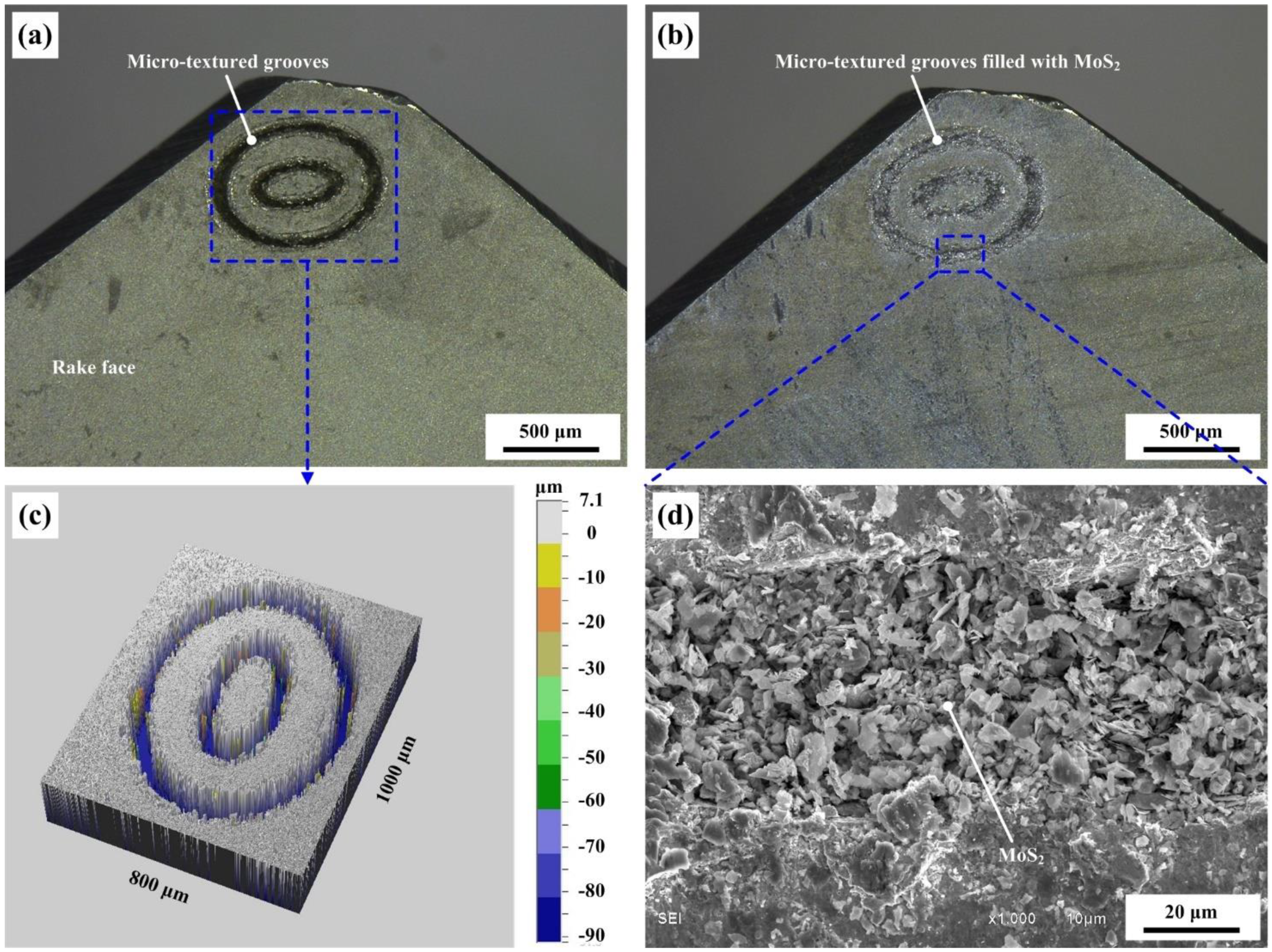
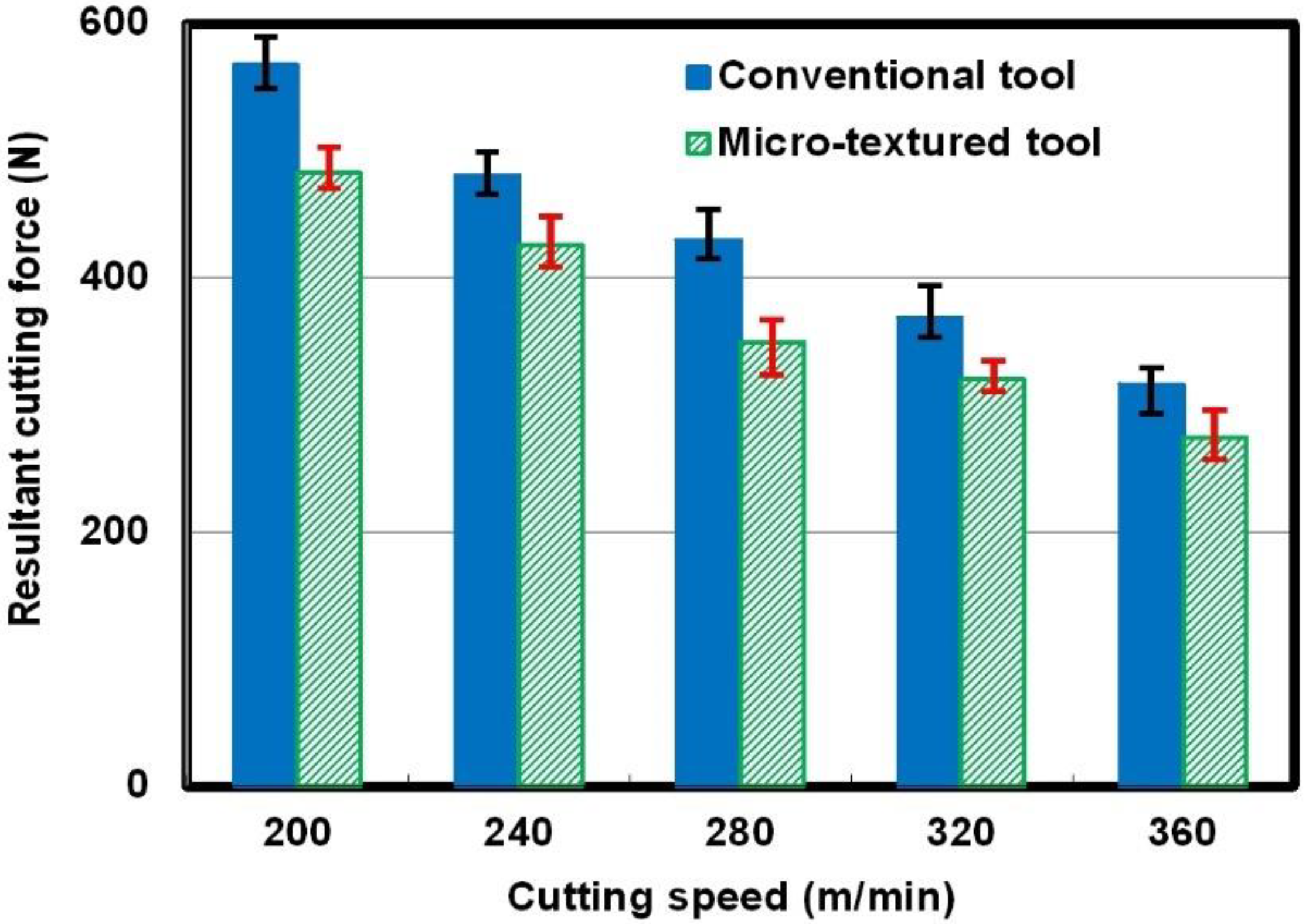
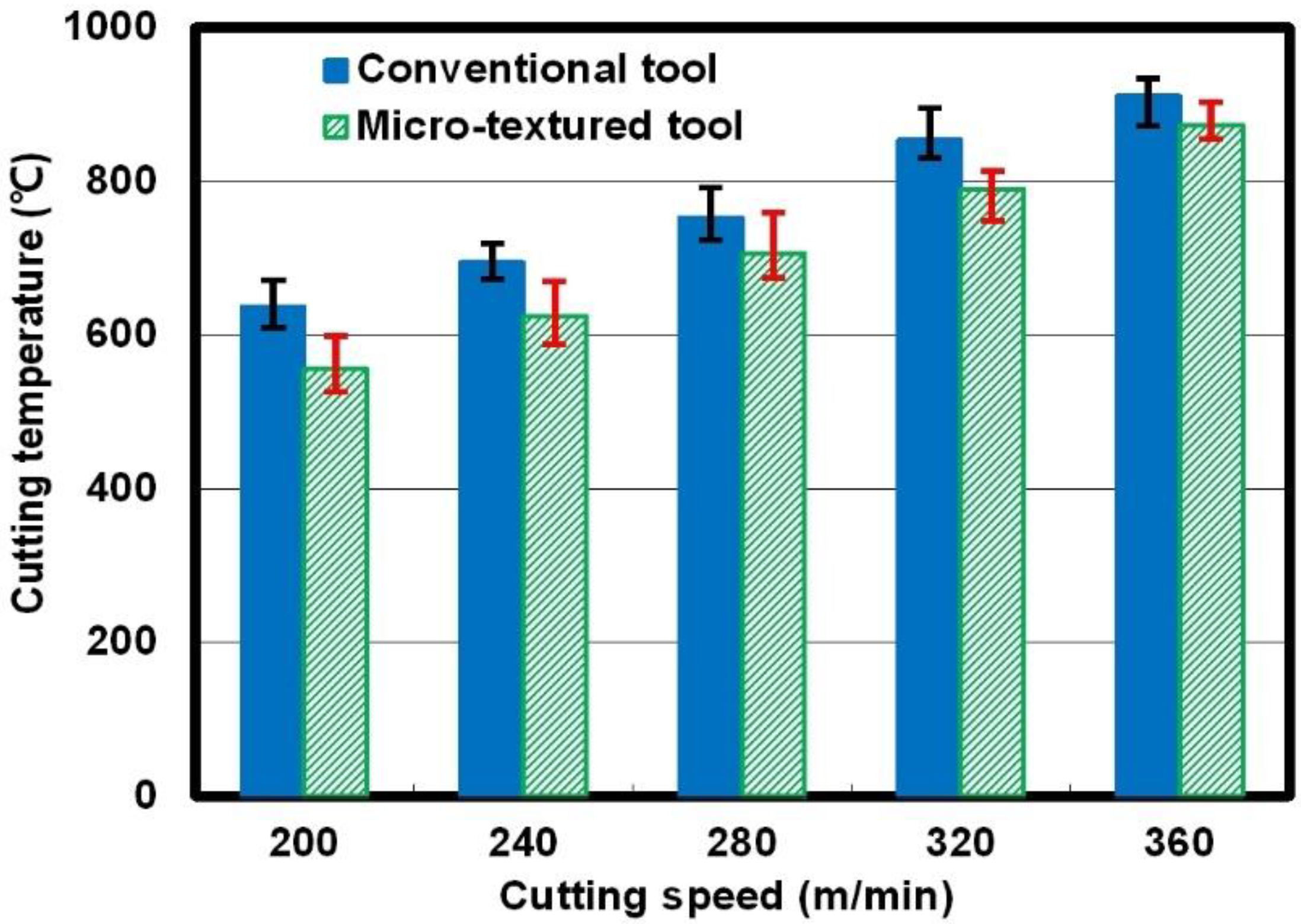
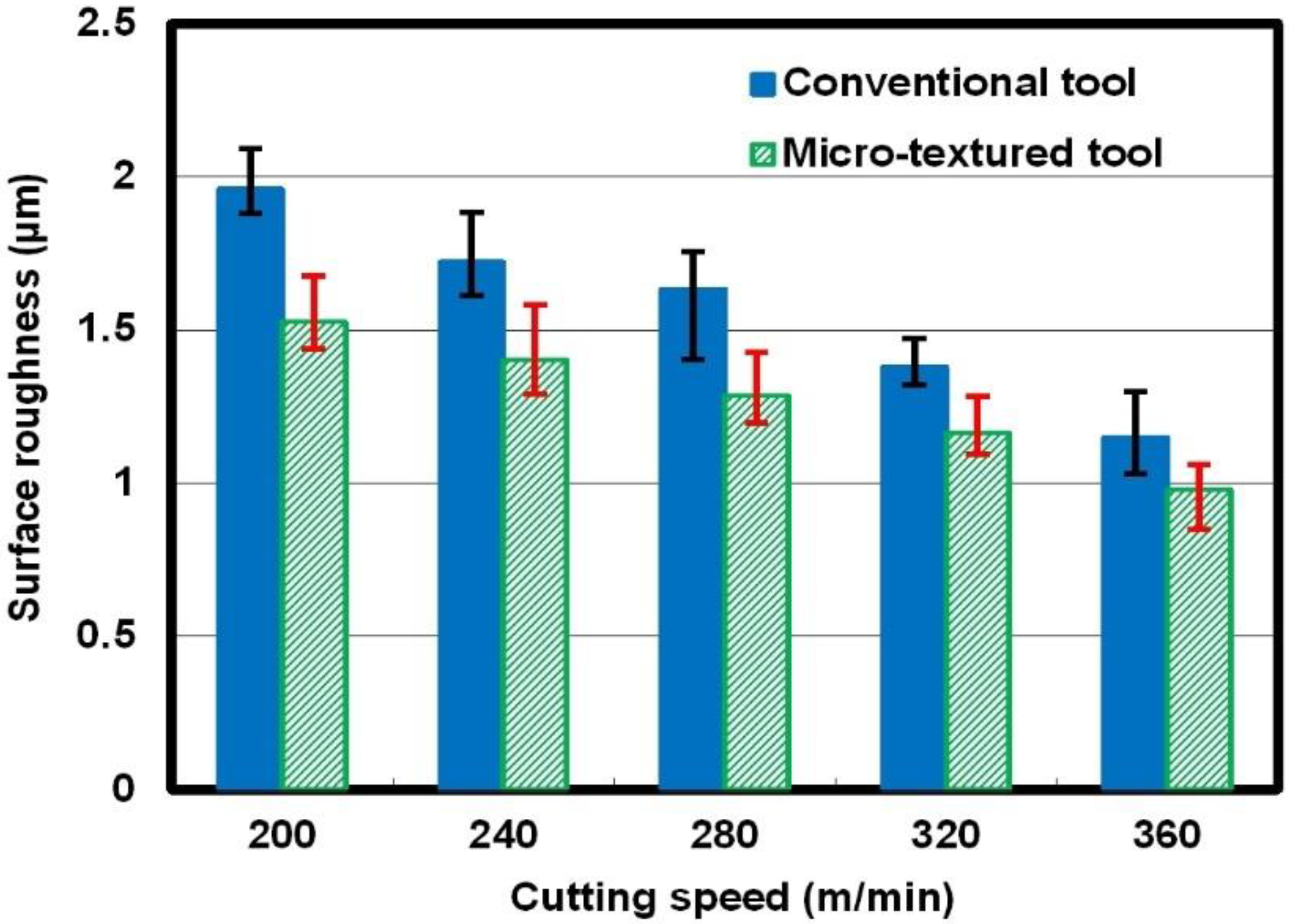
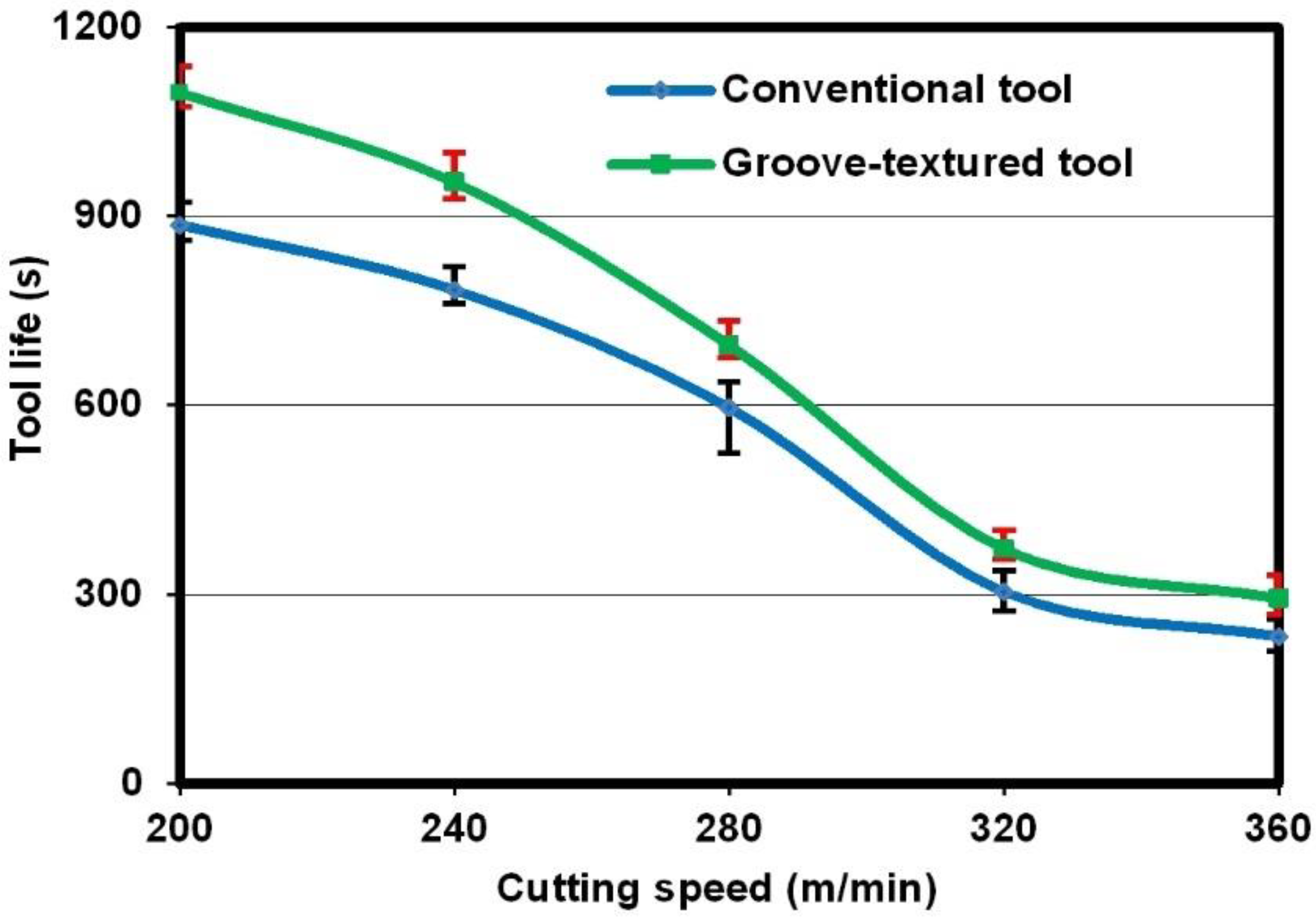


| Composition (wt%) | Hardness (HRA) | Thermal Conductivity (W/m·k) | Thermal Expansion Coefficient (10−6/k) | Density (g/cm3) |
|---|---|---|---|---|
| WC + 6%Co | 92.0 | 52.3 | 4.8 | 15.4 |
| Test | Cutting Speed, v (m/Min) | Feed per Tooth, fz (mm/z) | Axial Depth of Cut, ap (mm) | Radial Width of Cut, ae (mm) | Error Term | Energy Consumption per Unit of Volume, W (kJ/mm3) |
|---|---|---|---|---|---|---|
| 1 | 200 | 0.05 | 0.5 | 15 | 1 | 0.082 |
| 2 | 200 | 0.1 | 1 | 30 | 2 | 0.074 |
| 3 | 200 | 0.2 | 1.5 | 50 | 3 | 0.068 |
| 4 | 200 | 0.3 | 2 | 80 | 4 | 0.063 |
| 5 | 240 | 0.05 | 1 | 50 | 4 | 0.076 |
| 6 | 240 | 0.1 | 0.5 | 80 | 3 | 0.071 |
| 7 | 240 | 0.2 | 2 | 15 | 2 | 0.083 |
| 8 | 240 | 0.3 | 1.5 | 30 | 1 | 0.079 |
| 9 | 280 | 0.05 | 1.5 | 80 | 2 | 0.071 |
| 10 | 280 | 0.1 | 2 | 50 | 1 | 0.075 |
| 11 | 280 | 0.2 | 0.5 | 30 | 4 | 0.081 |
| 12 | 280 | 0.3 | 1 | 15 | 3 | 0.092 |
| 13 | 320 | 0.05 | 2 | 30 | 3 | 0.065 |
| 14 | 320 | 0.1 | 1.5 | 15 | 4 | 0.078 |
| 15 | 320 | 0.2 | 1 | 80 | 1 | 0.063 |
| 16 | 320 | 0.3 | 0.5 | 50 | 2 | 0.069 |
| Source of Variance | Sum of Squares (×10−6) | Degree of Freedom | Variance (×10−6) | Test F | F | Percentage of Contribution (%) |
|---|---|---|---|---|---|---|
| Cutting speed | 296 | 3 | 98.7 | 37 | 5.39 a | 29.96 |
| Feed per tooth | 20 | 3 | 6.7 | 2.5 | 9.28 b | 2.02 |
| Axial depth of cut | 48 | 3 | 16 | 6 | 29.5 c | 4.86 |
| Radial width of cut | 616 | 3 | 205.3 | 77 | 62.35 | |
| Error | 8 | 3 | 2.7 | 0.81 | ||
| Total | 988 | 15 | 100 |
Publisher’s Note: MDPI stays neutral with regard to jurisdictional claims in published maps and institutional affiliations. |
© 2021 by the authors. Licensee MDPI, Basel, Switzerland. This article is an open access article distributed under the terms and conditions of the Creative Commons Attribution (CC BY) license (https://creativecommons.org/licenses/by/4.0/).
Share and Cite
Wu, Z.; Xing, Y.; Chen, J. Improving the Performance of Micro-Textured Cutting Tools in Dry Milling of Ti-6Al-4V Alloys. Micromachines 2021, 12, 945. https://doi.org/10.3390/mi12080945
Wu Z, Xing Y, Chen J. Improving the Performance of Micro-Textured Cutting Tools in Dry Milling of Ti-6Al-4V Alloys. Micromachines. 2021; 12(8):945. https://doi.org/10.3390/mi12080945
Chicago/Turabian StyleWu, Ze, Youqiang Xing, and Jiansong Chen. 2021. "Improving the Performance of Micro-Textured Cutting Tools in Dry Milling of Ti-6Al-4V Alloys" Micromachines 12, no. 8: 945. https://doi.org/10.3390/mi12080945
APA StyleWu, Z., Xing, Y., & Chen, J. (2021). Improving the Performance of Micro-Textured Cutting Tools in Dry Milling of Ti-6Al-4V Alloys. Micromachines, 12(8), 945. https://doi.org/10.3390/mi12080945






